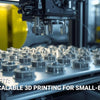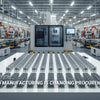What Is an On-Demand Die Casting Hybrid Line and How Does It Work?

What Is an On-Demand Die Casting Hybrid Line and How Does It Work?

Manufacturing leaders face a tough choice every day. Therefore, they must decide between running high-volume production lines that deliver low per-unit costs or maintaining the flexibility to handle custom orders. However, traditional die casting operations struggle with this balance. As a result, many manufacturers lose profitable small-batch opportunities because their equipment takes too long to switch between different parts. Furthermore, the market now demands both speed and variety, which creates a pressing need for a new approach.
Quick Answer: What You Need to Know
An on-demand die casting hybrid line combines digital order management with flexible production cells to handle both large and small batches profitably.
Key Benefits at a Glance:
| Advantage | Impact |
|---|---|
| Changeover Time | Reduced from hours to minutes |
| Lead Time | Compressed from weeks to days |
| Batch Flexibility | Handles orders from 50 to 5,000+ units |
| Work-in-Progress | Cut by 40-60% through continuous flow |
Who needs this system? Manufacturers serving automotive and industrial machinery sectors where customer specifications change frequently and delivery speed creates competitive advantage.
Now that you understand the basic concept, let's explore how each component works together. Additionally, we'll examine the technologies that make this system possible and the specific gains you can expect from implementation.
Table of Contents
- What Makes a Die Casting Line "Hybrid" and "On-Demand"?
- How Do Quick Mold Change Systems Enable Small Batch Production?
- What Role Do AGVs Play in Creating Seamless Production Flow?
- How Does Digital Order Flow Connect to the Physical Production Floor?
What Makes a Die Casting Line "Hybrid" and "On-Demand"?
Traditional production lines excel at one thing: making thousands of identical parts continuously. However, they fail when customers need variety. In contrast, the on-demand die casting hybrid line represents a fundamental shift in how foundries approach production planning.
The Core Differences
Traditional Die Casting Setup:
- Optimized for 10,000+ unit runs
- 4-8 hour mold changeovers
- Manual scheduling and material handling
- Fixed production sequences
Hybrid Line Approach:
- Handles batches from 50 to 10,000+ units
- 15-30 minute automated changeovers
- Digital scheduling with real-time adjustments
- Flexible cell configuration

How the Hybrid Model Works
The system breaks away from rigid production sequences. Instead, it creates what engineers call a flexible die casting cell structure. Consequently, each workstation operates semi-independently while staying connected through digital controls and automated material flow.
Moreover, the "on-demand" component refers to how orders trigger production. When a customer places an order through the digital portal, the system automatically evaluates which cell can handle the job fastest. Then, it prepares the required tooling and schedules the production run without human intervention.
This approach solves the classic manufacturing dilemma. Therefore, you can maintain high utilization rates on your die casting equipment while serving customers who need smaller quantities or faster delivery times.
How Do Quick Mold Change Systems Enable Small Batch Production?
The tooling challenge has always limited die casting flexibility. After all, creating precision steel molds costs $15,000 to $100,000+ depending on part complexity. Therefore, manufacturers traditionally needed large order quantities to justify these investments.
The Economics Shift with Quick Mold Change
Quick mold change die casting technology attacks the time problem rather than the tooling cost itself. By reducing changeover time from 6 hours to 20 minutes, you can profitably run batches as small as 100 pieces.
Time Savings Breakdown:
- Traditional changeover: 4-8 hours
- Semi-automated systems: 45-90 minutes
- Fully automated QMC: 15-30 minutes
- Result: 85-95% reduction in non-productive time

Two Technologies That Make It Possible
First, automated clamping systems replace manual bolt-tightening. Instead of workers spending hours securing molds with dozens of bolts, hydraulic clamps lock the entire tool set in minutes. Furthermore, these systems maintain consistent clamping pressure, which improves part quality consistency.
Second, rapid tooling methods lower the entry barrier for small-volume work. For prototype runs or orders under 500 units, manufacturers now use softer tool steels or even 3D-printed mold inserts. While these tools wear faster, they cost 60-80% less than traditional hardened steel molds.
Additionally, the return on investment becomes clear quickly. If your die casting press sits idle for 6 hours during changeovers, you lose approximately $2,400 in potential production time per changeover (assuming $400/hour operating cost). By contrast, a 30-minute changeover costs only $200 in downtime.
Therefore, even with the capital investment in QMC equipment ($150,000-$400,000), most manufacturers achieve payback within 18-24 months through increased machine utilization alone.
What Role Do AGVs Play in Creating Seamless Production Flow?
Material handling creates hidden bottlenecks in most foundries. Workers spend valuable time moving castings between cooling stations, machining centers, and inspection areas. Meanwhile, parts sit in queues waiting for the next operation.
Building Continuous Flow with Automated Transport
AGV integration die casting solves the logistics puzzle by creating a synchronized material flow system. These vehicles follow predetermined paths, picking up parts at precisely the right moment and delivering them to the next workstation.
The AGV Journey Through Production:
- Raw Material Delivery → AGVs transport ingots from storage to melting furnaces
- Casting Transfer → Hot castings move from press to controlled cooling stations
- Machining Connection → Cooled parts travel to CNC machining centers
- Final Dispatch → Finished components proceed to inspection and packaging
The Hidden Benefits Beyond Transport
While moving materials seems straightforward, AGVs contribute to agile die casting production in less obvious ways. First, they eliminate manual handling errors that damage castings. Second, they maintain consistent process timing because computer-controlled vehicles don't take breaks or get distracted.
Moreover, AGVs dramatically reduce work-in-progress inventory. In traditional setups, you might have 200-300 castings sitting between operations. However, with synchronized AGV transport, this number drops to 30-50 pieces because parts continuously flow to the next step.
Furthermore, the system adapts to priority changes instantly. If a rush order enters production, the control software simply reprograms AGV routes to fast-track those specific parts. Consequently, you can meet urgent customer needs without disrupting the entire production schedule.
This integration proves especially valuable for automotive suppliers who face constant pressure to reduce lead times while maintaining just-in-time delivery requirements.
How Does Digital Order Flow Connect to the Physical Production Floor?
The gap between receiving orders and starting production wastes more time than most managers realize. Sales teams email specifications to planners, who manually check capacity and create work orders. Then, someone walks paperwork to the production floor. Finally, supervisors figure out which machine can handle the job.
Creating the Digital Nervous System
Digital order flow manufacturing eliminates these delays by creating direct connections between customer requests and machine-level execution. When an order arrives through the web portal, software immediately begins working.
The Automated Sequence:
Step 1: Intelligent Validation
The system checks material inventory, verifies mold availability, and confirms delivery dates against production capacity. Additionally, it flags any specification conflicts or tooling limitations before human review.
Step 2: Smart Scheduling
Rather than assigning jobs first-come-first-served, the algorithm groups similar parts to minimize changeovers. Therefore, if three orders need the same mold, it schedules them consecutively to maximize efficiency.
Step 3: Automatic Preparation
The tooling room receives digital instructions to prep specific molds. Meanwhile, the QMC system reserves time slots on the appropriate presses. Furthermore, AGVs pre-position required materials near the selected production cell.
Step 4: Real-Time Execution Monitoring
Once production starts, sensors track actual cycle times and quality metrics. If problems arise, the system alerts supervisors immediately rather than discovering issues hours later during final inspection.
The Paperless Advantage
Traditional manufacturing generates mountains of paperwork. In contrast, the hybrid manufacturing line operates entirely on digital work instructions displayed at each workstation. Operators scan QR codes to confirm they're working on the correct job, and the system automatically records completion timestamps.
Moreover, this digital approach enables rapid response die casting capabilities. When customers need design changes or delivery acceleration, updates flow instantly to all affected workstations. Consequently, you can accommodate modifications that would require days or weeks in paper-based systems.
The connection between digital and physical systems also improves for manufacturers using multiple processes. For example, facilities offering both die casting and investment casting can route orders to the most appropriate process based on real-time capacity and cost optimization.
Conclusion
The on-demand die casting hybrid line represents a practical solution to the manufacturing flexibility challenge. By combining quick mold change systems, AGV-driven material flow, and digital order integration, manufacturers can profitably serve both high-volume and custom production requirements.
Key Takeaways for Implementation
Measurable Business Impact:
- Overall Equipment Effectiveness (OEE) typically increases 15-25%
- Lead times compress by 40-60% for small to medium batches
- Machine utilization improves 20-35% through reduced changeover downtime
- Work-in-progress inventory decreases 50-70%
Investment Considerations:
Most hybrid line conversions require $800,000 to $2.5 million in capital depending on facility size and existing automation levels. However, the combination of increased throughput, reduced labor costs, and ability to win higher-margin small-batch orders typically delivers ROI within 2-3 years.
Getting Started:
You don't need to convert your entire facility overnight. Many manufacturers begin with a single pilot cell serving industrial machinery customers who value quick turnaround. After proving the concept, they gradually expand the hybrid approach to additional production lines.
The competitive advantage comes not from technology alone, but from the ability to promise delivery times competitors cannot match while maintaining cost competitiveness. Therefore, the hybrid line becomes a strategic differentiator rather than just an operational improvement.
Recommended Resources
[Agile die casting production][^1]
[Quick mold change die casting][^2]
[Digital order flow manufacturing][^3]
[Hybrid manufacturing line][^4]
[AGV integration die casting][^5]
[Rapid response die casting][^6]
---
[^1]: Explore this link to understand how Agile die casting production can enhance efficiency and reduce costs in manufacturing.
[^2]: Discover the advantages of quick mold change die casting and how it can streamline your production process.
[^3]: Explore this link to understand how digital order flow manufacturing can streamline processes and enhance efficiency in production.
[^4]: Discover the benefits of hybrid manufacturing lines, which combine traditional and advanced techniques for improved productivity.
[^5]: Explore this link to understand how AGV integration enhances efficiency in die casting processes.
[^6]: Learn about rapid response die casting to discover how it can significantly reduce production times and costs.





